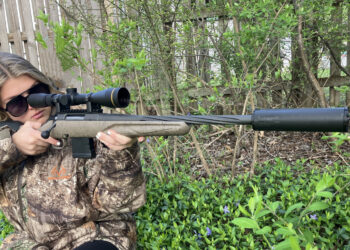By Frank Iannamico
Brief History of Kalashnikov Pattern Rifles in the USA

Today, U.S. collectors and shooters enjoy a plethora of AK variants. Together with both rifles and spare parts sets being imported from many former communist countries, and a wide variety of U.S. made stamped and milled receivers, an accurate representation semiautomatic AK clone from just about any nation or time period can be purchased or assembled. However, this wasn’t always the case as for many years importation of such goods from communist nations was banned, and AK rifles rare. Prior to the early 1980s there were no semiautomatic AK rifles available in the U.S. and few collectors had ever even seen an AK type firearm other than in photographs. The 7.62x39mm ammunition was equally scarce. The few authentic AK rifles (most were Chinese made Type 56s) that did make it to U.S. shores were war trophies illegally brought back with troops that had served in Vietnam, only a few of which were successfully registered in the 1968 Amnesty Program. One of the stumbling blocks of importing semi-auto AK type rifles into the United States was virtually all of them were produced in communist countries, and therefore banned from importation by the U.S. State Department.
It was only a matter of time before someone figured out that there was a large potential market for a reasonably priced, faithful semiautomatic AK rifle. When the Egyptian, Chinese, Hungarian and Yugoslavian AKs were eventually imported they were the AKM models with the stamped sheet metal receivers. To meet BATF requirements, the rifles were altered to make them “not readily convertible” to function full-automatic. To meet those requirements the bolt carriers had the surface designed to actuate the trip lever, which was also omitted, milled off. The disconnector, hammer and sear were also modified to permit semiautomatic-only fire. During the period the semiautomatic AK rifles, especially the Chinese made versions (now banned), were so prolific and inexpensive that no one ever considered that they would someday be sought after and greatly escalate in value.

Post Ban AK Rifles
Unfortunately, a few of the semiautomatic AKs fell into the hands of criminals and the mentally unstable who used them to commit heinous and senseless crimes. The media used terms like “assault rifles” and “machine guns” to over-dramatize these unfortunate incidents and bring negative public attention to the guns, instead of the perpetrators themselves. Before long everyone in America knew what an “AK-47” was, but few could name the handful of criminals that had, in most cases illegally obtained the guns, and used them to commit the crimes. The word “semiautomatic” became an evil media buzzword, with the general public being led to believe it meant “machine gun.” In one typical over-dramatization, a Midwest big-city newspaper editorial proclaimed that AK-47 rifles were illegal for hunting because they were so powerful that “animals would be vaporized when struck by their bullets.” Similar disinformation abounded, often embellished by the media. As a result, new laws were enacted that further restricted the rights of law-abiding guns owners and did nothing to affect criminals, who as a rule ignore laws. The criminal acts combined with largely inaccurate reporting by the media resulted in a federal ban on so called “assault rifles.”
Before long foreign manufacturers introduced new “politically correct” models and received permission to import them into the U.S. The new models were void of the nefarious features named in the import ban such as; folding stocks, pistol grips, grenade launchers and bayonet lugs. After the import ban and subsequent appearance of sporter-style AKs, interest in the rifles began to wane, despite a substantial decrease in price. The primary reason was the unattractive and clumsy thumbhole stock. It was illegal to re-configure a postban rifle into a preban configuration and postban rifles had their date of manufacture stamped on the receiver to discourage such practices. Since the passing of the import ban, grandfathered preban AK rifles fitted with all of the “evil” features experienced a huge increase in price, while at the same time the retail price of postban rifles dropped dramatically. From the ban an entire new breed of AK rifles and nomenclatures emerged. Generally speaking, AK rifles produced after the ban were referred to as postban or sporters and guns manufactured prior to the ban were called preban guns. The postban AK rifles were reconfigured to comply with the new laws and thus be legally imported into the U.S. The new models were renamed as the MAK-90, MAK-91, NHM-90, NHM-91, BWK-92 and the AK Hunter.
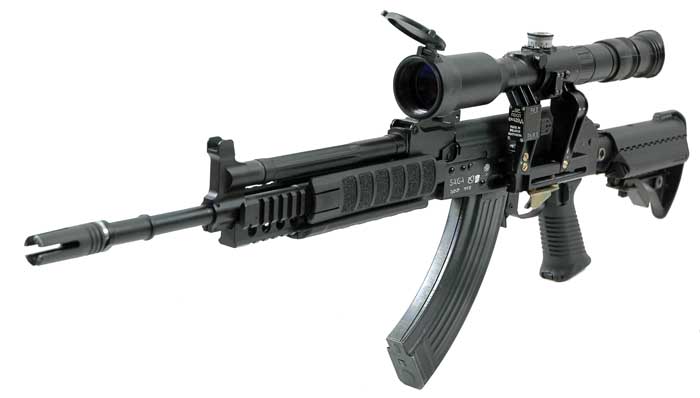
During 1997 President Bill Clinton ordered the Secretary of the Treasury Robert Rubin to review the list of the banned “assault” rifles that had been specifically modified to be legal for importation. Under the 1968 Gun Control Act, the Treasury Department had the authority to restrict the importation of firearms unless they were determined to be “particularly suitable for or readily adaptable to sporting purposes.” After taking several months to review the weapons in question, the Treasury Department concluded that modified semiautomatic assault rifles that accept large capacity military magazines do not meet the “sporting purposes” test and were generally not importable. As a result of the study, President Clinton announced on April 6, 1998 that over fifty modified versions of assault rifles would no longer be importable because of their ability to accept a high-capacity magazine. Virtually all of the remaining sporter variants of the AK rifles were therefore banned from importation.
The Violent Crime Control and Law Enforcement Act, AKA The 1994 Assault Weapon Ban
The Federal Assault Weapons Ban was a subtitle of the Violent Crime Control and Law Enforcement Act of 1994, a federal law of the United States that included a prohibition of the sale to civilians of certain semiautomatic “assault weapons” manufactured after the date of the ban’s enactment. This law also banned possession of newly manufactured magazines capable of holding more than ten rounds of ammunition. The ten-year ban was passed by Congress on 13 September 1994 and was signed into law by President Clinton the same day. Included in the bill was a ten-year sunset provision. A sunset provision is a condition in a statute regulation that terminates or repeals all or portions of the law after a specific date, unless further legislative action is taken to extend it.

September 13, 2004
The “assault rifle” sunset provision of the Violent Crime Control and Law Enforcement Act of 1994 was allowed to expire on 13 September 2004. Since the expiration of the assault rifle ban portion of the 1994 crime bill, it has been legal to assemble a semiautomatic AK rifle from any of the many AK part sets available, as long as the rifle is in compliance with U.S. Code 18 section 922 paragraph r, which states a semiautomatic rifle cannot have more than ten of the imported parts listed in paragraph c. When applied to an AK rifle, the law requires a minimum use of six U.S. manufactured components for a stamped receiver rifle, and a minimum of five components in a milled receiver variant. Due to the milled receiver’s lack of a separate barrel trunnion, it is considered to have one less part than a comparable stamped receiver model. U.S. made parts that are available include; receivers, gas pistons, pistol grips, buttstocks, front handguards, flash hiders, muzzle brakes, triggers, hammers and disconnectors. A semiautomatic AK rifle with a sufficient number of U.S. manufactured parts may be legally built from a commercial receiver or made from a receiver flat available from many sources. Before long, AK clones were once again available. Some of the AK parts and rifles were now available from sources like Bulgaria, Romanian and even Russia. During the 1990s the Warsaw Pact passed into history and most of its former members began to apply for membership in NATO. During 1991 some restrictions were lifted and small arms ammunition began to be imported from Romania as well as other former Warsaw Pact countries. This event, AK rifles manufactured in a former Warsaw Pact country available in the U.S., was unimaginable when the first AK rifles were imported during the 1980s.
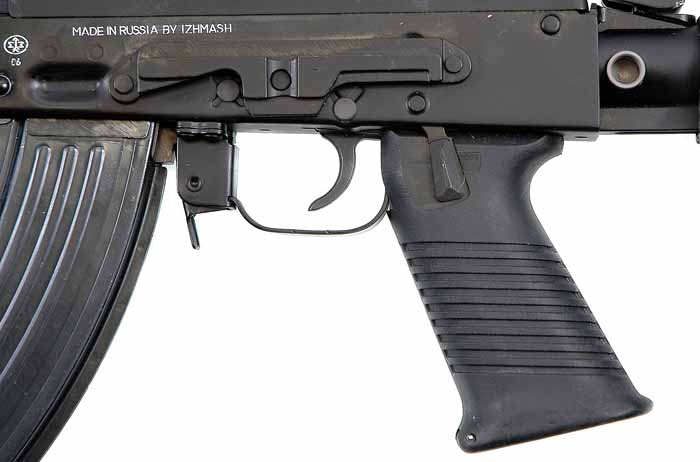
Russian made AK rifles, being the benchmark by which all other AK are measured, are the most desired variant. Russia however has contributed very little to the U.S. collector market in the way of the availability of rifles, magazines, parts and accessories. This situation is due in part to the Russian Federation’s strict export policies on military weapons and equipment. When found, genuine Russian parts and accessories can be prohibitively expensive.
The Russian Saiga Rifles
The Izhmash Saiga line of AK-based civilian hunting rifles are named after the Saiga, a species of antelope that originally inhabited a vast area of Asia, but is now considered an endangered species found only in Kazakhstan and Western Mongolia. The animals were primarily hunted for their hides, which were sold and exported to a number of countries. An AK based hunting rifle was first designed in the late 1970s for professional hunters in Kazakhstan for controlling the increasing Saiga population in that area. A very limited number of these rifles were manufactured. In order to establish a presence in the civilian rifle market Izhmash, the primary Russian AK rifle factory, resurrected the concept of this early hunting rifle with their new Saiga line.

Currently the Saiga civilian hunting rifles are a semiautomatic-only series of AK rifles and shotguns produced at the Izhmash AK plant. The rifles are based on the latest AK-100 series with a few exceptions; the rifles have five or ten round capacity magazines that will not interchange with high-capacity military magazines. There are no bayonet lugs or muzzle brakes fitted. The internal parts and receivers have been specifically designed to prevent the rifles from being illegally converted to fire full-automatic through the use of military components. One unique feature of the Saiga rifle series is the chamber of the barrel that was designed to leave a distinct ring on the neck of a fired cartridge case. This feature was reportedly implemented in the event that an AK rifle was involved in a crime as it would assist authorities in determining if the rifle in question was a civilian Saiga or a stolen military weapon.
The primary objective of designing the Saiga series was to implement the legendary reliability of the proven Kalashnikov system into an affordable civilian hunting rifle. Although traditional wood furniture is available, most of the sporting style one-piece stocks on Saiga models are fabricated from black polyamide plastic, as are the limited capacity magazines. The Saiga was originally designed for the AK 7.62x39mm cartridge, but is also available chambered for the .223 Remington and .308 Winchester cartridges. There are several barrel lengths available from 16.3 to 21.8-inches depending on the caliber, and all are chromium-lined. For mounting optical devices the Saiga rifles come fitted with the standard Russian pattern side mounted rail. To be compatible with their conventional hunting style buttstocks it was necessary to redesign the fire control group to relocate the trigger and trigger guard further to the rear of the receiver. The adjustable rear sight is realistically calibrated out to a distance of 300 meters (328 yards).
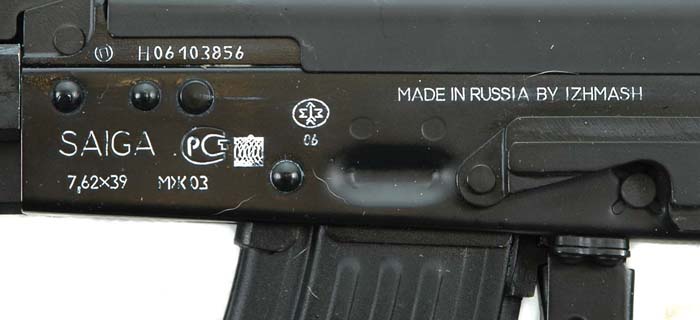
Saiga Importers
Big Bear Arms of Dallas, Texas was the first importer of the Saiga line of rifles during 1993-94. Then, B-West of Tucson, Arizona, imported Saiga semiautomatic rifles for the U.S. civilian market from Russia during 1994. Two five-round plastic magazines were shipped with the rifles. There was also a Saiga 410 shotgun imported by B-West.
During 1996 the Saiga line was imported by Kalashnikov-USA operating out of Port Saint Lucy in Florida. Although the original amount of rifles imported was small the number continually increased.
In 1999, the European American Armory of Rockledge, Florida took over importation of Saiga rifles. During this period new models were imported and these included the Saiga-308 and Saiga-556, chambered for the U.S. .308 caliber round and the .223 respectively. Currently, the complete line of Saiga hunting and target rifles and shotguns are imported by the Russian-American Armory Company and is distributed through a network of dealers.
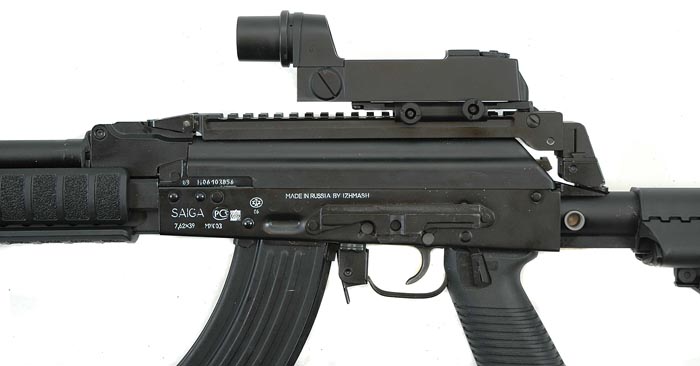
Russian American Armory
The Russian American Armory, located in Scottsburg, Indiana, imports from Russia the Saiga line of semiautomatic hunting rifles. The Saiga rifles were developed based on the venerable Kalashnikov assault rifle design and adapted for the sportsman hunting large and medium-size game. The Saiga rifles, like their military counterparts, are reliable under a wide range of climatic conditions. The Saiga line now includes a number of semiautomatic shotguns based on the proven Kalashnikov system.
While the Saiga line of AK rifles are of genuine Russian manufacture, their “politically correct” sporter configuration is not particularly attractive to most AK enthusiasts. The Saiga line was designed in a way that makes converting it into a “real” AK configuration more than a matter of simply swapping out parts. The Saiga trigger group was moved rearward and secured with permanent axis pins. This design makes the addition of a pistol grip difficult requiring the trigger assembly and trigger guard to be moved forward. This task entails drilling or milling out trigger guard rivets and axis pins and the filling in of holes left in the receiver after the relocating of the components. The Saiga was also designed to use low-capacity proprietary magazines as standard AK military magazine will not fit or function. Lastly, in order to legally convert a Saiga “sporter” into a military configuration requires a number of U.S. manufactured components.
Fortunately for those not equipped to perform such AK “surgery” there exists entities that specialize in such work.
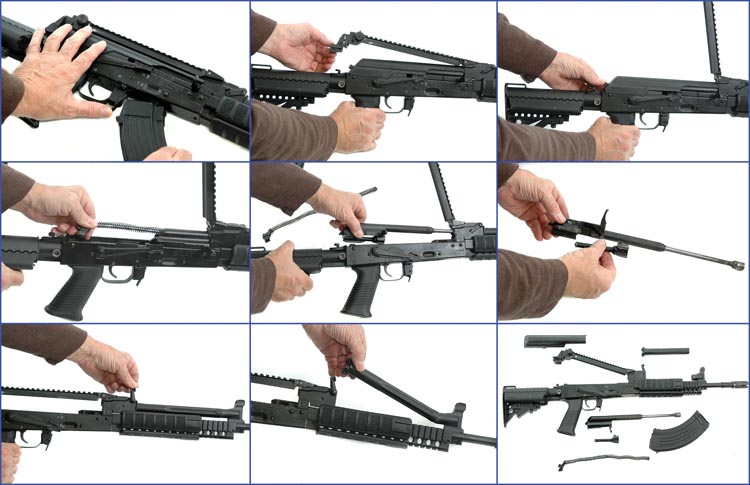
1. Remove the magazine from the receiver and visually inspect the chamber to insure the rifle is not loaded. 2. On rifles equipped with a top rail, rotate the cam lever to release the lock. Lift the rail upward. 3. Depress the protruding end of the recoil spring guide at the rear of the top cover. While holding the button inward lift the top cover upward to remove it from the receiver. 4. Push the spring guide forward to slide it out of its retaining notch, then pull it rearward to remove it from the rifle. 5. Place the selector lever in the fire position and slide the bolt carrier assembly rearward. 6. Rotate the bolt to remove it from the bolt carrier. 7. Remove the gas tube by rotating its locking lever into a vertical position. 8. Lift the back of the tube upward to remove it. 9. Field stripped AK rifle.
Krebs Custom
Marc Krebs of Krebs Custom, Wauconda, Illinois is an AK enthusiast and a nationally known gunsmith, garnering his initial fame from building high-quality 1911 pistols for IPSC and IDPA competitions as well as personal protection handguns. Krebs Custom has more recently become very well known and respected among AK enthusiasts for applying their gunsmith skills to build AK rifles. As an AK enthusiast, Marc Krebs realized that the most desired, albeit unobtainable, AK would be a Russian made example. With this in mind he decided to obtain Russian made Saiga sporter rifles, with genuine Izhmash factory made receivers, and convert them into a military configuration.
With the Saiga rifles as a foundation, Krebs Custom offers an innovative line of AK rifles. During the building process, Krebs Custom relocates the trigger assembly forward in order to add a pistol grip and the original Saiga trigger and transfer bar pin-holes are welded up and carefully blended into the surrounding metal. The Saiga receivers are then modified so that any standard AK magazine can be used. Many of Krebs’ rifles feature an exact copy of the famous and effective Russian muzzle brake CNC machined from 4130 bar stock. During the build process, all of the correct cleaning rod brackets, as well as synthetic military stocks and foregrips are used. Special attention is focused on the trigger group and action removing all the existing burrs, rough edges and geometric inconsistencies that are common in factory mass-produced AK rifles resulting in a very smooth precise feel not normally encountered with AK weapons. Like original factory AK rifles, Krebs completes the job by applying a flat black painted finish that is baked on for durability and to resist damage from chemicals such as bore cleaner.
Krebs’ attention to detail and quality workmanship coupled with the Izhmash Arsenal AK rifles result in a Russian Kalashnikov rifle that is extraordinarily smooth, accurate, reliable and aesthetically pleasing. In the conversion from sporter to military configuration, Krebs Custom uses only high quality new parts: what original parts are not available Krebs manufactures in-house, insuring that all of the parts meet or exceed the quality of the original Russian components.
Krebs Custom offers a variety of models to satisfy everyone from the purist to the modern tactical rifle aficionado. Offerings range from their AK-103 clone to highly modified models like the KTR-08 rifle with such features as a three-rail handguard, light single-stage trigger, enhanced safety lever, thumb-operated selector, windage adjustable aperture rear sights with a M1913 Picatinny rail, and VLTOR telescoping stocks. Krebs Custom AK rifles are available in many popular calibers to include 7.62x39mm, 7.62x51mm (.308) and 12 gauge semiautomatic Saiga shotguns.
For those desiring to upgrade their own AK rifles, Krebs’ line of parts and accessories are available separately. Krebs offers a number of items designed to enhance the appearance or functionality of AK pattern rifles. Some of the items available include; vertical foregrips, AK-74 pattern muzzle brakes in .22 or .30 caliber, VLTOR flashlight holders, enhanced selector levers with a bolt hold-back feature, aperture style rear sights, custom shotgun sights, Picatinny rail forends and VLTOR AR-15 type telescoping buttstocks designed for AK rifles.
Note: Due to the ever-changing availability of rifles, parts, part sets and magazines, it is suggested that the company be contacted directly for current availability of their products and services. Potential buyers should check their local and state laws, which may prohibit ownership of semiautomatic AK type rifles.
Sources
Krebs Custom
1000 Rand Rd
Wauconda, IL 60084
Ph: (847) 487-7776
Fax: (847) 487-7778
Email: krebscustom@krebscustom.com
Website: www.krebscustom.com/index.shtml
Russian American Armory
677 S Cardinal Lane
Scottsburg, IN 47170
Ph: (877) 752-2894
Email: info@raacfirearms.com
Website: www.raacfirearms.com/contact.htm
Kalinka Optics Warehouse
254 Junco Circle
Longs, SC 29568
Email: info@kalinkaoptics.com
Website: www.kalinkaoptics.com
| This article first appeared in Small Arms Review V13N7 (April 2010) |





